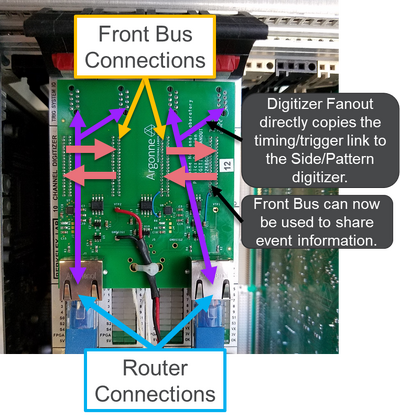Digitizers

Gammasphere's digitizers, as the name suggests, digitize signals from each detector. They are an important part of the DAQ system and are housed inside VME Crates with triggers and IOCs. They take signals that have been conditioned in the pickoff card and routed from the collector box and communicate with the triggers to determine which signals are worthy enough to digitize. Digitizers continuously convert signals into streams of numbers, which are called ADC samples. Data from the ADCs of the digitizer are signed 14-bit values that arrive at 100MHz (10ns period). Each digitizer module implements ten channels that implement independent input and energy integration blocks. The purpose of the input and energy integration firmware block, implemented as a pipeline, is to receive the data, internally trigger on edges of signals and calculate the energy of the input signal. Following each energy integrator is a pending event queue and event acceptance logic block that places accepted events into channel-specific FIFO buffers. At the back end, a channel readout machine collects all data from the channels and stuffs accepted events into a large external readout FIFO, accessible over the VME backplane. Figure 1 shows a typical set of 4 digitizers. Only the so-called "Center/Sum digitizers", are connected to the Router Trigger. These digitizers can both receive triggers and transmit event data to the Triggers. The secondary or Side/Pattern digitizers receive a copy of the trigger data and the clock from their neighbor over the Front Bus cable. While this provides access to the clock and trigger link data, the communication is one way. With the Front Bus being used in this way, there is little to no possibility for these Side/Pattern digitizers to participate in the trigger or veto logic in system, as there is very little connectivity remaining for the secondary digitizers to send data back over the front bus.
Digitizers Before Upgrades
The experiments at Argonne National Laboratory (Gammasphere, FMA, DSSD, HELIOS) have instrumented their detectors with digital data acquisition systems using the digitizer module developed for the GRETINA experiment. Although the hardware is the same, the differing architectures of the experiments and different detector structures necessitated completely new and unique firmware in both the digitizer and trigger modules. A generic firmware design from which specific variants for each of the Argonne Tandem Linear Accelerator System (ATLAS) experiments can be derived is described herein. It is our hope that this firmware development, where all channels are independent and equal, may be utilized in other experiments as well. As of 2018, Digital Gammasphere (DGS), Digital FMA (DFMA), HELIOS (Helical Orbit Spectrometer) plus the X-Array all use this firmware.
The digitizer module design and the original GRETINA firmware developed for it are products of Lawrence Berkeley National Laboratory (LBNL). The trigger module and its firmware are products of Argonne National Laboratory (ANL). We at Argonne thank our LBNL collaborators for sharing the source code and schematics of the digitizer module, both of which were invaluable references in this totally new firmware development.
Two versions of firmware have been developed, a Master build and a Slave build. These operate identically in virtually all ways save that the Master build directly interfaces to the trigger system and the Slave build receives its clock and control signals from the trigger over a front panel cable driven by the Master.
Interface to Gammasphere Detectors
The signals from detectors are processed through external analog interface modules before connection to the digitizer. Digital Gammasphere ‘pickoff cards’ differentiate the single-ended input Ge Center signal to remove the long ramp and reset associated with the transistor-reset preamplifiers. The original control/monitoring/power system developed in the 1990s, the ‘pickoff cards’ designed in the early 2000s, and all cabling have been replaced. The Slope Box Extension is a new system that provides all the features originally envisioned for the ‘pickoff’ cards that were not implemented in the original design, plus completely replaces the old control/monitoring/power system. As of 2023, Gammasphere has been converted to Slope Box Extension hardware.
Irrespective of old system or new, the signals are all driven differentially into the digitizer with a variable DC offset. The signal applied to all digitizer channels is unipolar with the dominant time constant defined by the RC timing of the channel. The time constant of the pickoff card for the Ge Center channel is nominally 50us; detectors with Slope Box Extension systems have programmable time constants. The BGO and Ge Side signals are natively unipolar as driven by the detector and so are simply amplified and converted to differential; the time constants of the BGO and Ge Side signals are similar to those of the Ge Center channel. Typically the differential signals are offset by approximately 1.5V so that the un-driven signal rests near but not at the one rail of the digitizer module’s input range (i.e. around ADC channel 2000 for Ge Center signals). This allows the maximum dynamic range for the unipolar signals. The fourth signal from each detector is called the BGO pattern. This last signal can be used to monitor the individual BGO tubes that form the BGO sum signal and can also monitor the Ge Center at a different gain for calibration purposes. It also has a mode in which the signal is driven by seven comparators, each with a fixed and binary-weighted analog swing, to provide a mix of tube activity indicator and time-over-threshold energy information from all 7 BGO channels simultaneously.
For more information on digitizer firmware see Advanced User Guides
Go back to Digital Gammasphere Upgrade Project